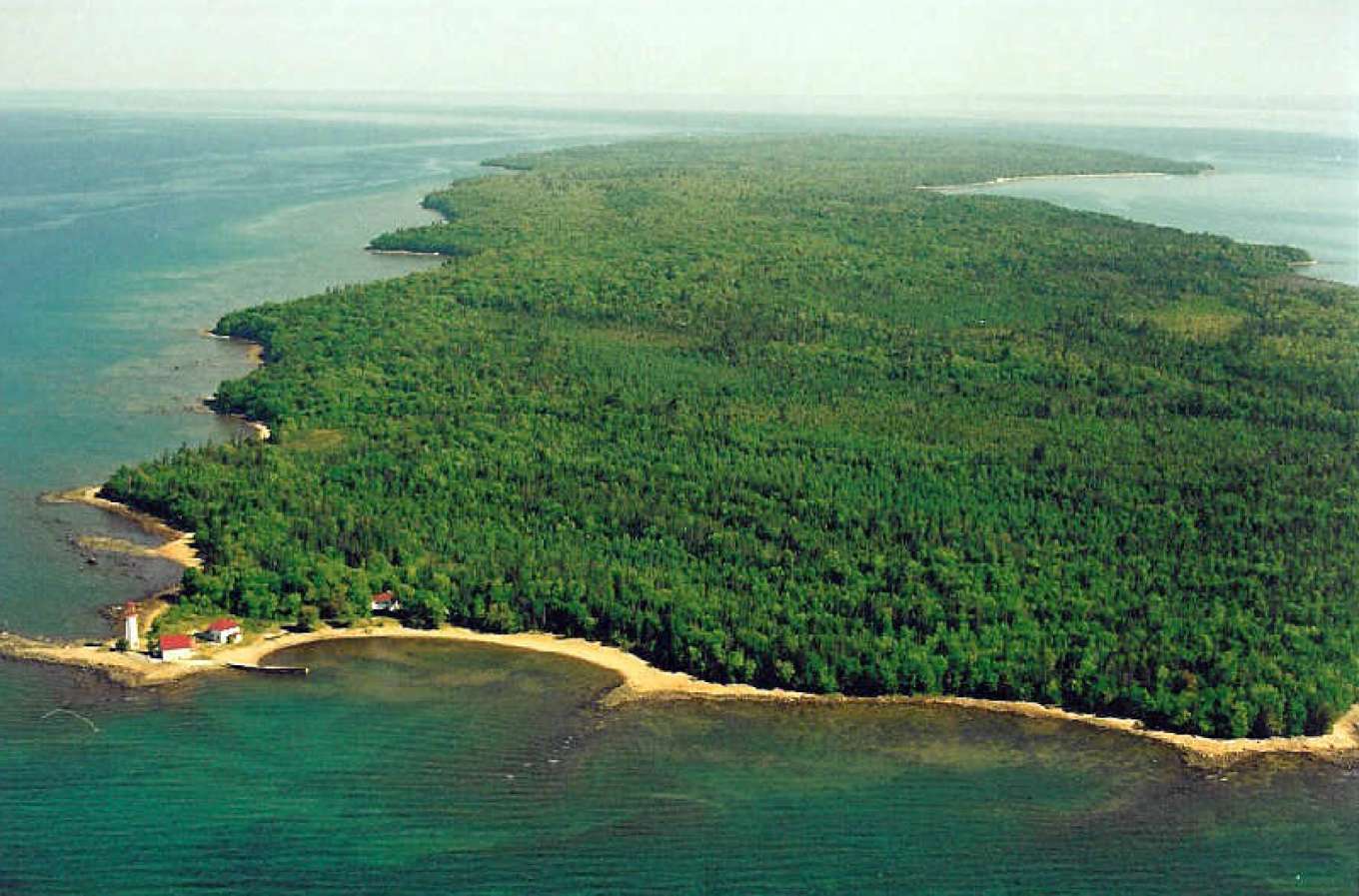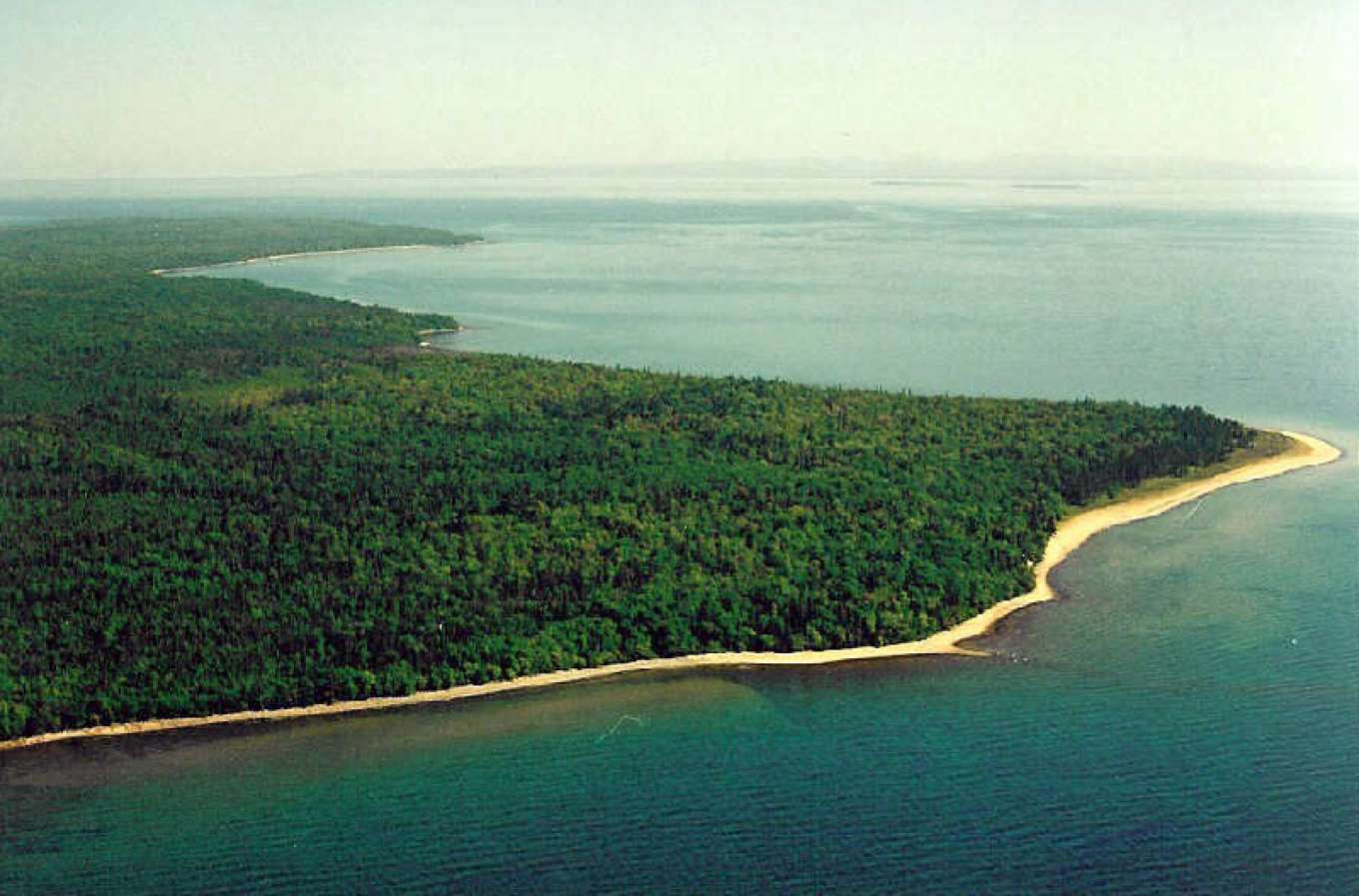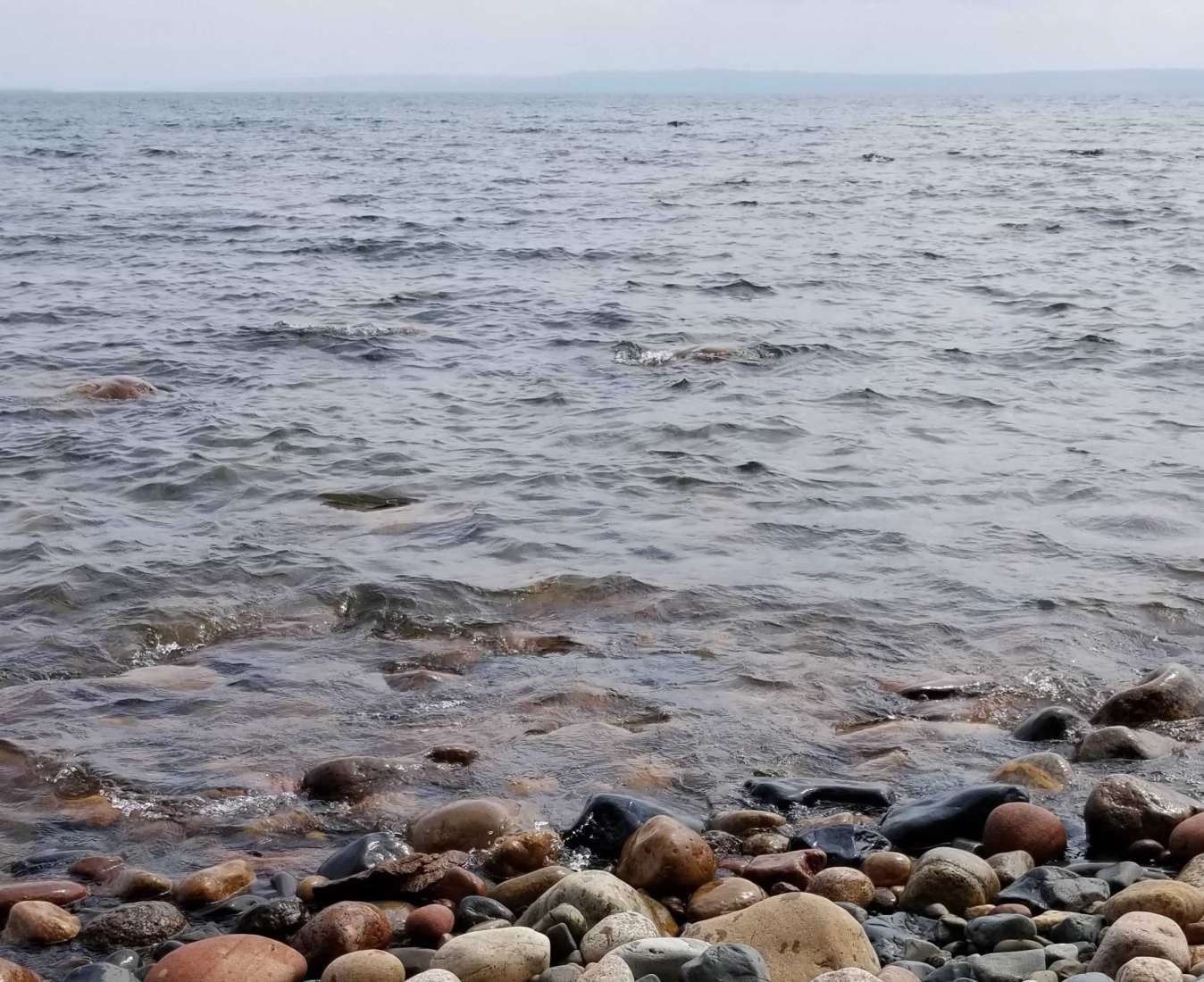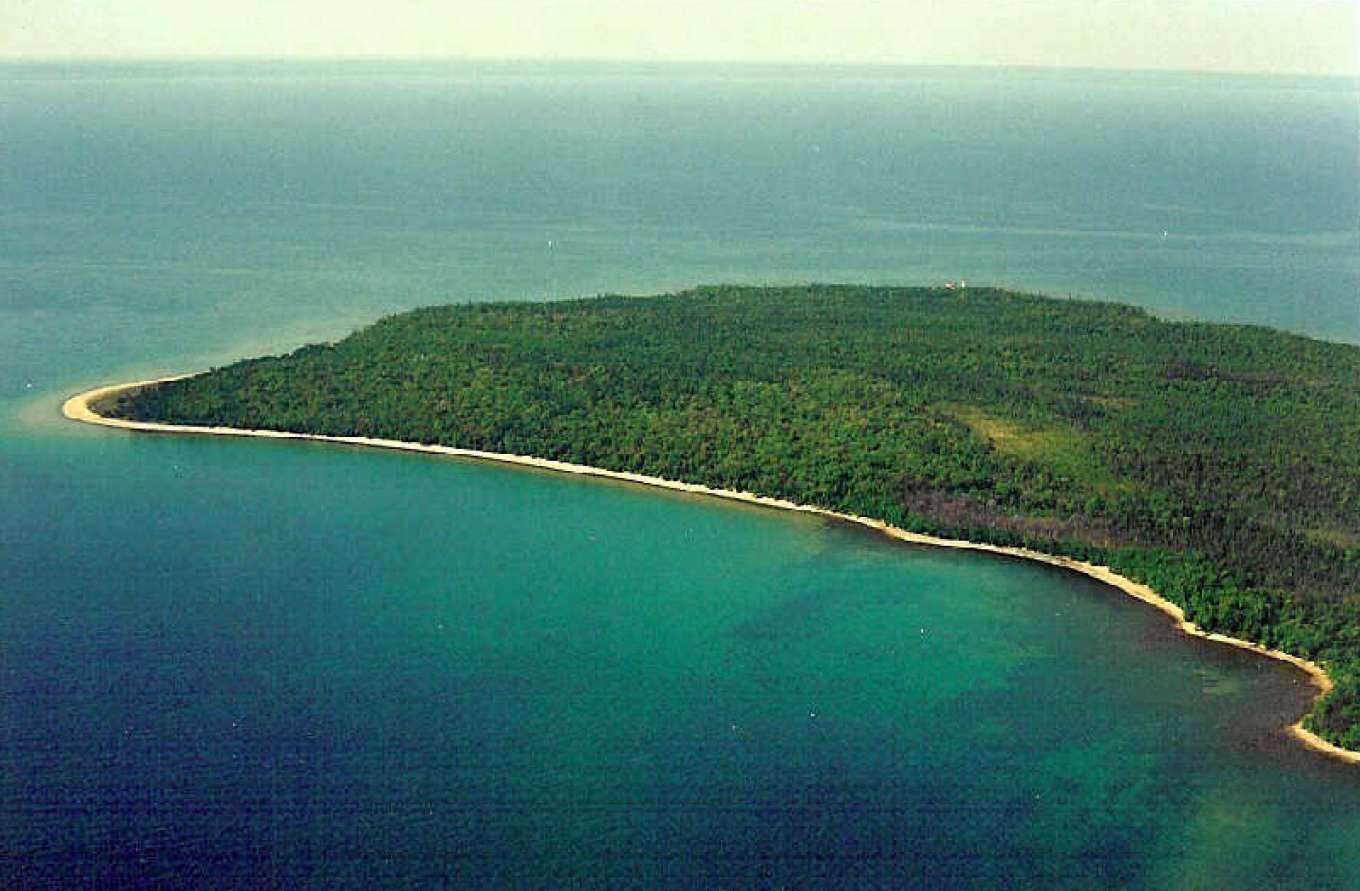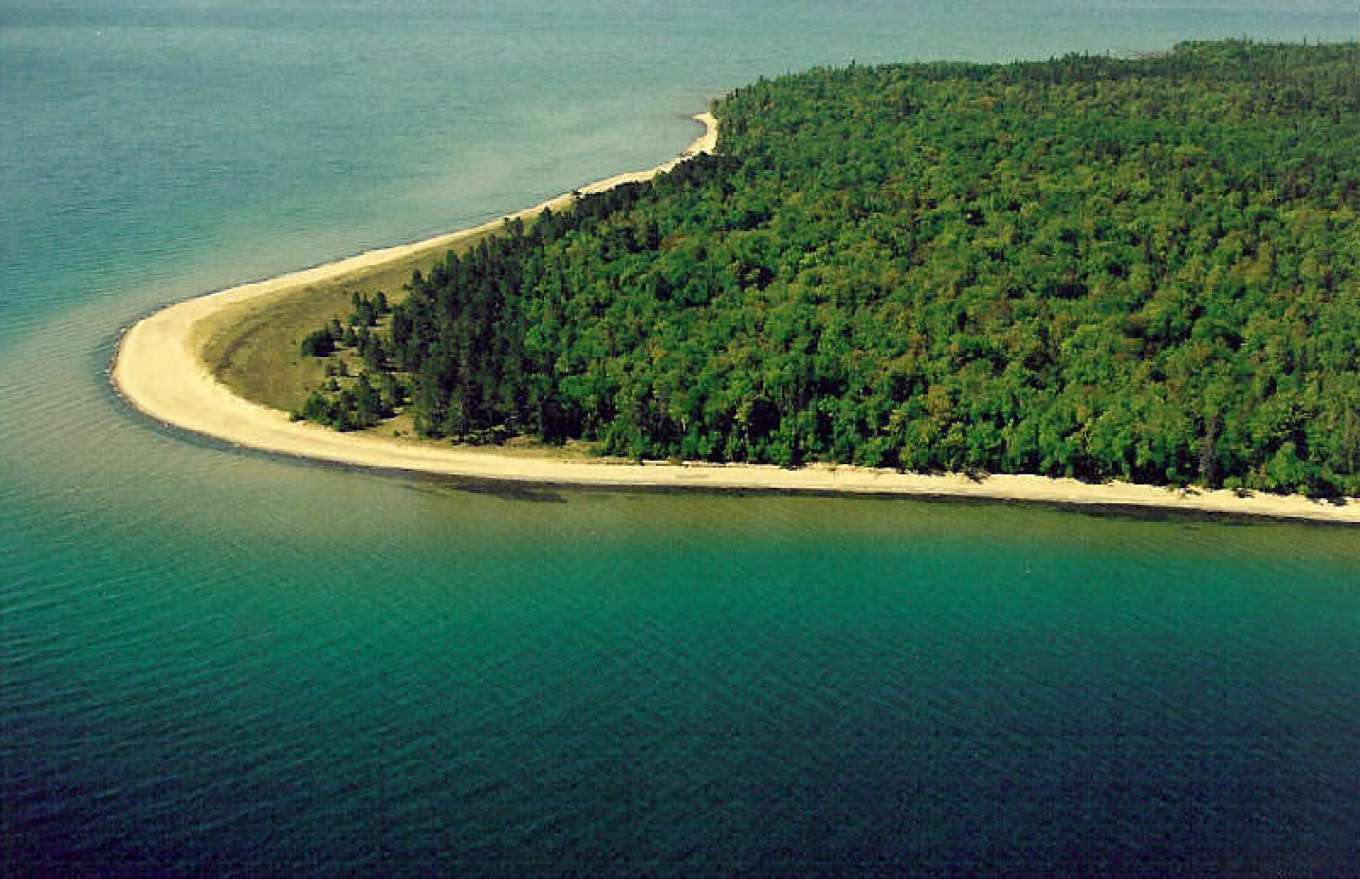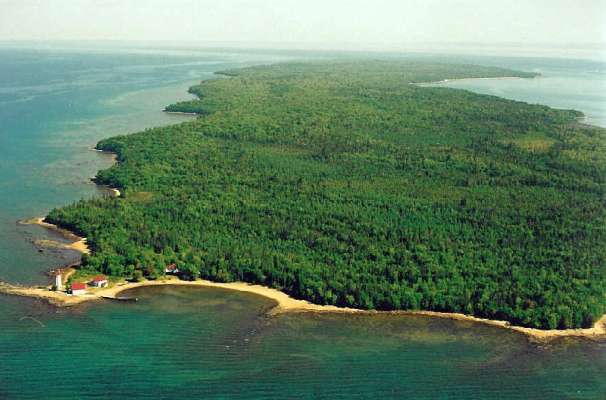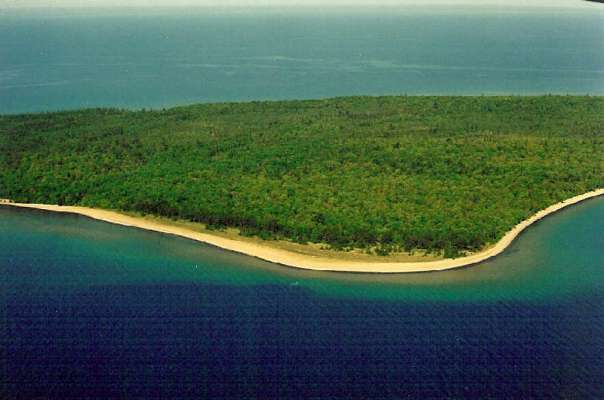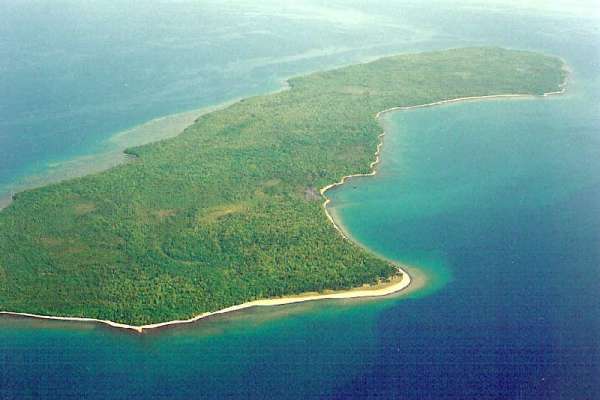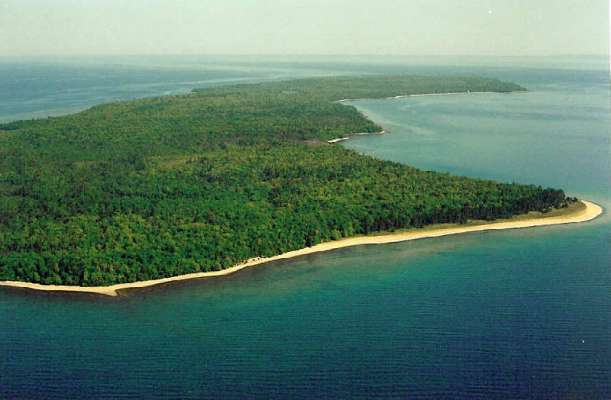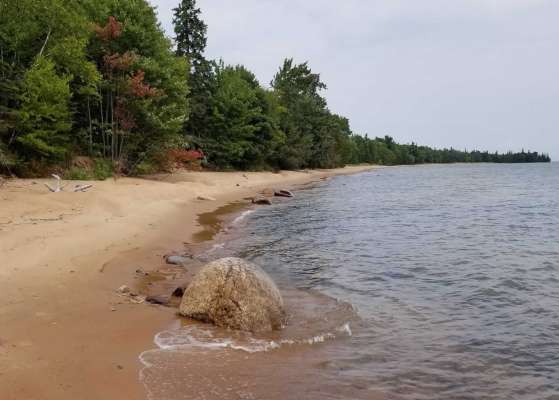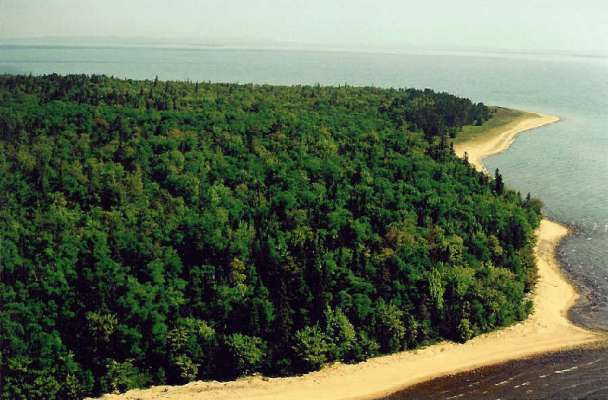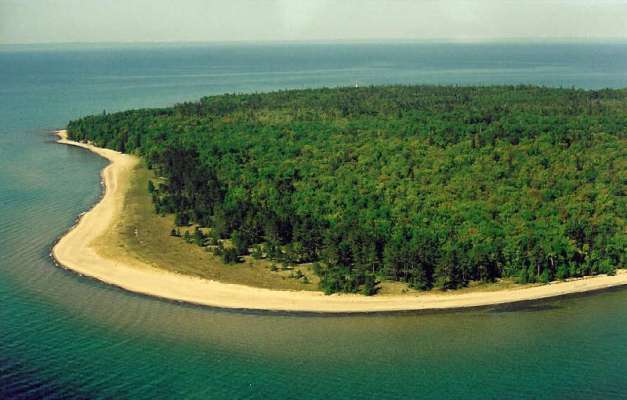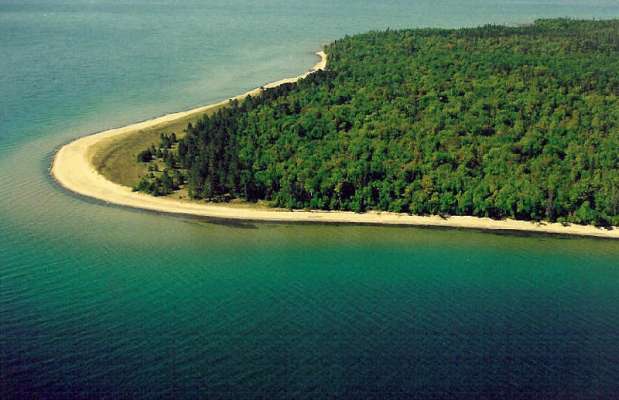Parisian Island
NEW PRICE!
With more than one mile of beachfront, and somewhat more than 114 acres of woodland and shore, this land parcel encompasses the entire southeastern corner of Parisienne Island, in Whitefish Bay, Lake Superior. It is the totality of privately owned land on the island.
The white sand beaches, facing both south and east, are broad and splendid. Behind the beaches, to a depth of more than one quarter ...
NEW PRICE!
With more than one mile of beachfront, and somewhat more than 114 acres of woodland and shore, this land parcel encompasses the entire southeastern corner of Parisienne Island, in Whitefish Bay, Lake Superior. It is the totality of privately owned land on the island.
The white sand beaches, facing both south and east, are broad and splendid. Behind the beaches, to a depth of more than one quarter of a mile, the land becomes first open meadows, then meadows with scattered trees, and (toward the center of the island) virgin forest.
I give below, without exaggeration, a full description of the parcel, whose pieces have been gathered over four decades. I am very proud of it. In describing this island, and this land, words fall short.
Location of Parisian Island
Parisian Island (also identified as Ile Parisienne) lies midway between the Canadian and American shores of the narrow, eastern neck of Lake Superior, known as Whitefish Bay. The island will be found on most automobile road maps, lying about 10 miles east-southeast of Whitefish Point, Michigan, and about 6 miles west the Canadian shore.
The nearest town on the American side is Paradise, Michigan; on the Canadian side the closest town is Gros Cap, Ontario, a small fishing hamlet about 8 miles west of Sault Ste. Marie. The boundary line between the U.S. and Canada runs diagonally through the middle of Lake Superior in a SE-NW direction); Parisian Island lies one mile east of this line, in the district of Algoma, Ontario. About six miles from northern to southern tip, the linear axis of Parisian Island runs NNW-SSE. It is widest (about 1½ mile) at the southern end, and narrows to about 2/3 mile across near the northern end.
Character of the Island
The terrain of the island is slightly rolling, for the most part thickly wooded. Low cliffs extend along much of the windward, western shore. Along the eastern and southern shores (where this parcel lies) the land inclines very gently into the lake. A sandy and pebbled beach, broken only by occasional points of land, runs up the entire length of the island's eastern side. Near the northern end of the island there is a small lake in its center. At the wide southern end of the island (much of which is within this parcel) the shore is a long run of spectacular sand beach. Here the beach is very wide, and the water (protected from western and northerly winds) is perfectly clear and usually quite calm. Behind the wide beaches on the southern shore lie extended reaches of open meadow between the woods and the water. Parisian island is uninhabited. On the southwestern tip of the island, less than a mile from this parcel, there is a lighthouse, a very pretty and important one, which guides Lake Superior shipping from the open lake toward the mouth of the St. Mary River to the southeast, and on to Lake Huron and eastward ports. The lighthouse complex is very well cared for by the Canadian government; it includes a small harbor and wharf, a helicopter landing pad, and some outbuildings. There are no other buildings on the island. The forests on Parisian Island have (to the best of my knowledge) never been cut; beautiful, virgin forest covers much of the center of the island.
Land Ownership on Parisian Island
Only one segment of the island, its southeastern corner, is privately held. That is the parcel here described, which I own. All the remainder is owned by the Canadian Crown and is (as of April 2001) known as the Ile Parisienne Conservation Reserve. A notice from the Ontario Ministry of Natural Resources of 22 August 2001, explains that this Reserve (which of course does not include the privately held parcel) will be protected from industrial activities, including commercial forestry, hydroelectric development, mining, and aggregate and peat extraction. Traditional recreational and resource uses such as hunting, fishing, hiking, canoeing, boating, and fur trapping, will generally be permitted to continue within the conservation reserve...
Because the Canadian Government will sell no land bordering on the Great Lakes, Parisian Island will remain in its natural condition, as a Conservation Reserve, never to be developed, in perpetuity. It is insulated from the rest of civilization by the waters of the cleanest and most magnificent lake in the world. The owner of this private parcel (on which structures can be erected, of course) therefore has the effective recreational use and enjoyment of the entire island. The private holding of the southeastern corner of Parisian Island came to pass in the very early years of the 20th century, when the Crown sold one mile of beach front to a fish company, which dissolved not long afterward, nothing ever having been built on this property. Because the company had intended some uses of a stretch of land under the lake, a water lot was included in the transfer, which remains part of the parcel here described. The total acreage (including the water lot) is therefore something over 124. It is the only parcel ever to be available for private use on Parisian Island.
Exact Location and Shape of this Parcel
The southeastern corner of Parisian Island comes to a distinct, beachy point, which is on this property, not far from its center. From this point a wide sandy beach swings around to the south and then toward the west for a distance of about 1,700 feet. From that western boundary of the parcel it is an easy walk through the woods, or by way of the beach, to the lighthouse station described above at the southwestern point of the island. From the southeastern point northward the beach extends for miles, the first 3,500 feet of which are part of this parcel. On this eastern side the beach is narrower than on the south, with more frequent patches of pebble. Smooth and many-colored pebbles alternate with stretches of clean sand under the clear water as well. The land of the parcel extends westward back from the beach, its width varying because the western property line (near the E-W center of the island) is straight, but the eastern shore curves slightly inward. The property is about 1,700 feet deep at the widest point, about 1,100 feet deep at the narrowest point. The ten-acre water lot (approximately 300 x 1,400) adjoins the eastern beaches, just north of the corner point. The entire parcel is roughly rectangular in shape, its longer dimension north-south, with the water lot projecting to the east from the southern end. There is substantial inexactitude in the account just given. This is a consequence of three facts.
The first is geological: Over the generations this corner of the island has been very slowly growing in size, the beaches widening as a result of a gradual lifting of the landmass, extending the beach out into the lake. Of course this growth is very slow, but the measurements upon which the charts are based were made many decades ago, and do not take account of the accretion of land since that time.
The second fact is historical: The technical description of Great Lakes frontage in Canada never includes what is called the "Queen's chain" or the sixty-six feet adjacent to the water of which, to prevent any destruction of the beach, the Crown technically remains in control. This has no significant effect upon the owner's enjoyment of the land.
The third fact is cartographical: Between the total acreage of the oldest plan (AR-31) of which a copy is attached, and a more recent survey (AR-230) also attached, there are some discrepancies. These several considerations result, I reckon, in a real total acreage of something nearer to 140 acres than 124. The water level of the Great Lakes does fluctuate slightly. But that fluctuation has little impact on Lake Superior because of its enormous size and depth. Two- or three-inch variations in the level of the big lake (and that's a lot!) have imperceptible impact on the beaches of Parisian Island.
Description of this Parcel A.
The beach. Words fail in describing it. I've combed beaches around the world, from Fiji and Samoa and New Zealand to Majorca and Capri, in the Bahamas and the Windward and Leeward Islands of the Caribbean, and throughout Michigan, and the Carolinas, Florida and Oregon. There are a very few beaches that are the equal of this Parisian Island beach: the Otago Peninsula in the South Island of New Zealand, and the beaches on Grand Cayman Island and Montserrat in the Caribbean, and some others. But I have never encountered any beach that could justly be called its superior. Of course, beaches have different kinds of excellence. This beach is long, open, and extended, like the very best beaches on Lake Michigan. The water here is as clear as crystal, and so pure that it is perfectly suitable for drinking. Rounded pebbles, every color of the rainbow, including agates if you know how to spot them, shine through at the water's edge. The sand is white, fine and soft. The lake water is very cold, but very safe to swim in because of the gentleness of the incline, the total absence of urchins or other visible sea life or any human waste, and because of its cleanliness. The water is sweeter and better to drink than that from any well or municipal water system. (The lighthouse keepers at Parisian island told me long ago that although they had good running water from a well in their houses, they preferred to take their drinking water from the lake, and always did so.) The lake bottom on the gentle incline is fine sand, with occasional patches of pebbles, without weed, or tar, or debris. When the wind blows, Lake Superior can get very rough. On the western shore, in a storm, the lake surf crashes against low cliffs with splendid fury. But this land parcel is on the eastern side and does not bear the brunt of the winds. Here the water is usually calm, sometimes with a gentle chop, or small waves. Along the long southern shore the water is usually very calm with a slight ripple, often as flat and inviting as the waters of an inland lake, even when there is a fair chop far out from land. At that southeastern (I call it home) point, where the southern and eastern beaches meet, one can stand on a low hill just back from shore and see the two beaches extending into the distance, each with its own character. In both directions the beach is unbroken, but it varies in width. On the southern side it is truly grand, on the eastern side the woods come closer to the water. Visiting small boats must anchor in the shallows just off the beach, which is safe enough when no storm threatens, or must be pulled up onto the sand. If neither of these is a satisfactory option, the boat must put in at the lighthouse harbor about a mile to the southwest. There is no wharf or other structure on the parcel itself, or anywhere on the island except at the lighthouse. The beaches are wonderfully clean. I've never encountered any oil residues on the eastern or the southern shore. There are no human artefacts, except the occasional pieces of flotsam from passing ships. Driftwood on the beach is abundant; much of it bleached milk white, all of it ideal firewood.
The meadows.
Behind the wide beach on the southern shore there are rolling fields, covered with grasses and lichens, creating acre after acre of open meadow superb for horseback riding, walking or playing. These meadows stretch back (northward) from the beach sand several hundred feet, for most of the southern length. An airstrip could readily be constructed here. The lichens on these meadows produce an almost solid cover of greyish green growth- insect free, soft and wonderfully clean. They are like a carpet to walk upon, or lie upon. As one crosses the meadows walking northward, the gradual southward advancement of the trees becomes evident. A few scattered jack pines come first, then small groups of conifers, mixed with a few deciduous trees creating some semi-protected enclosures. Within one of these semi-meadows I once laid out the lines of the house I would build, on a rise near home point, protected by great trees, with views of the lake on three sides. As one walks up the eastern shore, the meadows come to an end. The beach, still fine and wide, but somewhat rockier and not so grand, reaches back to meet a bank of sand and soil. Climbing the bank, 3 or 4 feet in height, one enters the woods.
The woods.
Much of this parcel is covered with what may be called Northern Michigan Climax Forest; magnificent trees, tall and old, both evergreen and broadleaf. There are many beeches of different kinds; also abundant are spectacular white birches, healthy and amazingly large of girth. Spruces and pines of substantial diameter and height are common. Variety is great. The forest is easily penetrated on foot, and is readily walk able. The forest floor is littered with fallen limbs and some small brush. But there is no mat of thick brush because the trees, long-standing, have beaten the low brush out. It would not be easy to clear the trees themselves- who would want to clear them? -but it is not very difficult to clear the ground beneath them for paths, and one could even create a sort of natural arboretum. At the edges of the forest blueberries grow wild (some call them huckleberries) in profusion. Their taste is super. All the land on which the forest grows indeed, all of the land of this parcel without exception is high and dry, well above the level of the lake, with a slightly undulating surface. I blazed a trail around the perimeter of the parcel some years ago, and marked some trails across it. These would be difficult to locate or follow now. But there is no need to be much concerned about trails because one cannot get lost. If one pushes steadily through the forest toward the east from any point, one comes soon to the beach. Then walking south to the corner point takes one home. Or from any point in the woods one can push south to the beach, and then walk the sand east to the point. One can walk in any direction in the center but there are stretches where fallen branches make the going a bit rough. I would never cut this forest. But I am told that the market value of the timber on this parcel is very great.
The views.
Looking out over the lake to the east one sees the distant hills on the Canadian mainland, across six miles of open water. They are only a little way inland, and appear purple in the distance. These are hills, some hundreds of feet high, but not really mountains; they stretch in a chain away to the north. (From the hills just north of Gros Cap, on the Canadian side, one can see Parisian Island in the far distance.) If one walks (through the woods or around by way of the beach) over to the western shore of the island and looks westward, one is looking toward Michigan but because the Michigan shore is nearly flat it is not visible from the island. So the view in this direction is of open lake, which is, so far as the eye can tell, an inland ocean but fresh! From the southern shore one sees the Canadian hills to the left, and the open water of the lake to the right, leading to the eastern end of Lake Superior, which is not visible, of course. There are many freighters moving ore and grain from the western ports in Lake Superior to Sault Ste. Marie to the east. and on to Chicago or Detroit, and to the St. Laurence Seaway to the Atlantic. All these ships pass the island, but at a very considerable distance, often barely visible. At night the lights of the far off ships, and their occasional foghorns, create a romantic flavor difficult to convey in words. These are ocean-going vessels, and fly the flags of many nations. The occasional package or bottle that washes up on the beach is as likely to have a German or Dutch label as an English one. Back at that southeastern corner near the home of tent or lodge as I picture it on a slight rise, one can look in three directions: to the hills, to the ships, and (because the point extends somewhat to the east of the body of the island) northward to the beaches and trees of Parisian Island itself, which curves inward to give one a spectacular view of one's own island base. More spectacular viewpoints than this one there are, of course, from mountaintops and canyon edges. But in my judgment there is no spot more satisfyingly beautiful than this in all the world. And no strangers are there to disturb one's seclusion.
Access to the Island.
There is no regular transport to Parisian Island. I've always hired a fisherman at the town of Gros Cap (on the Canadian side) to bring me and my companions to and fro, making pick-up arrangements in advance, or calling by CB radio. It would be equally easy to cross the lake from Paradise, in Michigan, south of Whitefish Point on the western shore of Whitefish Bay, where many boats are based. The strip of water to be crossed (from either side) is open and can be dangerous in bad weather. But if the lake is reasonably flat a powerful small boat can make the crossing very quickly. Helicopter transport is possible, to the landing pad at the lighthouse, or to the meadows on this parcel. A seaplane, also, could readily land in the quiet waters of the southern edge on a good day. An airstrip could be built on the island itself, with little earth moving. In winter, when this portion of Lake Superior is frozen over (the whole lake, I am told, never freezes!), one could make the crossing by snowmobile but that trip could be dangerous. The island has been protected by Lake Superior as by a moat, and kept pristine; but it is not distant, and transportation can be readily arranged. By late April, and in May, one encounters on Parisian Island some of the most gorgeous weather of the year. The summers are warm, but with cool lake breezes much of the time. The autumn months on the island are marvellous, crisp and gorgeous with color. In October there is commonly a period of genuine Indian Summer, a warm spell after the first freeze. By November the leaves of the deciduous trees have fallen, but the snows are not yet heavy and the weather is not yet severe. Radio contact with the Canadian coast guard is easy. In an emergency a radio message to the Coast Guard station at the Saulte Ste. Marie Airport can bring helicopter assistance within minutes.
Wildlife on the Island
Parisian island abounds with birds, their species and number varying with the time of year, but I know very little about birds and so cannot list the species seen. Mammals of significant size; raccoons, bears, coyotes, etc. are entirely absent; the habitat on the island is not right for them. Years ago one of the lighthouse keepers kept a beautiful German shepherd dog; and I brought my dog (then a small terrier) to the island on several occasions. It is a wonderful place for dogs; they cannot get lost, can do no harm, and have the run of the wild. One of the lightkeepers told me once that he had seen, while flying over the island, nine moose near its northern end. It may be that they came over on the ice one winter or it may be that the claimed sighting was really an illusion. I've walked long ways on the island and have never seen anything moose-like or deer-like. But that light keeper used to hike up the beach often, with his rifle, to the northern end, determined to bring down one of those moose! I am not a fisherman, but I am told that fishing in Lake Superior is very good. The whitefish there are reputed to be the best in the world, and the waters are fished by single fishermen and small groups, working mainly from small boats. I’m told that pike and other northern lake fish are also caught. Recall that this land was originally to be the home of a fish company.
The Value of this Land
This is a rare parcel. I've searched the globe and I've never seen anything like it. Everyone knows that the value of first-quality undeveloped land: land with excellent water, and beaches and forests rises inexorably. The demand for such land increases, the available supply steadily decreases. Substantial acreage, with extended beach frontage of first quality, is already very hard to come by. There is nothing I know of that is comparable. Parisian Island, of course, is not conveniently located as some resort areas are. But the parcel itself is much superior to most waterfront parcels on other lakes in Lake Michigan, or Glen lake, or Lake Huron. Its remoteness accounts for its unspoiled grandeur. No development of any kind will ever intrude upon this land; no road (save that built by the owner) will ever disturb it. Considering its intrinsic merits only, there is no land in the entire Great Lakes region that is its superior, and perhaps none that is its equal.
This great value is magnified, and made secure, by a set of factors that protect it as an investment:
1) The owner of this parcel has, for all practical purposes, the enjoyment of the entire island at his disposal. The great majority of the island is and always will be Crown land; so, whoever buys this parcel buys, in effect, the island. And what an island!
2) Of all the land on Parisian Island, this is the finest portion. Its beaches and meadows are not matched by even the finest lake properties in Michigan or Ontario. The quality here is absolutely superlative.
3) Seclusion on this parcel is unmatched. Utter privacy and huge spaces here combine. For a large private estate, for a corporate retreat, for a group camp or recreational facilities for play, or study, or sheer relaxation and escape into a dominion entirely one's own, and a dominion of incredible beauty, there is no matching it. It is a gargantuan private beach resort and private wilderness combined.
4) The sheer size of the parcel- more than a mile of beach frontage, more than one hundred acres of private forest give protection to the buyer not possible with smaller lots, or collections of lots, where resort development is underway.
5) Size gives flexibility to collaborate with others, to put to varied uses, to divide, to put to uses that demand great size. Superior beach frontage is rare. Parcels of such frontage that are also of great size are not to be found. If there is the like of this parcel anywhere, I do not know of it. These factors, -- summed up, perhaps by underscoring extraordinary beauty, great usefulness, and utter singularity provide the foundation of the great value of this land. Its value is further enhanced by the following considerations:
A) Although remote and secluded, it is but 15 minutes from Sault Ste. Marie by helicopter, less than two hours from Detroit or Chicago by private plane.
B) As undeveloped Canadian land, taxes on the property are virtually nil.
C) Standing timber on the land is of substantial value. I would hate to see it cut, but realistically it is there, and its sale could offset a portion of its purchase cost.
D) The steady rise in the market value of properties of this general kind gives promise that, as an investment, this is secure.
All questions about this parcel I will answer as fully and honestly as I am able to do. I offer this parcel for sale with great pride. Carl Cohen
NEW PRICE!
With more than one mile of beachfront, and somewhat more than 114 acres of woodland and shore, this land parcel encompasses the entire southeastern corner of Parisienne Island, in Whitefish Bay, Lake Superior. It is the totality of privately owned land on the island.
The white sand beaches, facing both south and east, are broad and splendid. Behind the beaches, to a depth of more than one quarter of a mile, the land becomes first open meadows, then meadows with scattered trees, and (toward the center of the island) virgin forest.
I give below, without exaggeration, a full description of the parcel, whose pieces have been gathered over four decades. I am very proud of it. In describing this island, and this land, words fall short.
Location of Parisian Island
Parisian Island (also identified as Ile Parisienne) lies midway between the Canadian and American shores of the narrow, eastern neck of Lake Superior, known as Whitefish Bay. The island will be found on most automobile road maps, lying about 10 miles east-southeast of Whitefish Point, Michigan, and about 6 miles west the Canadian shore.
The nearest town on the American side is Paradise, Michigan; on the Canadian side the closest town is Gros Cap, Ontario, a small fishing hamlet about 8 miles west of Sault Ste. Marie. The boundary line between the U.S. and Canada runs diagonally through the middle of Lake Superior in a SE-NW direction); Parisian Island lies one mile east of this line, in the district of Algoma, Ontario. About six miles from northern to southern tip, the linear axis of Parisian Island runs NNW-SSE. It is widest (about 1½ mile) at the southern end, and narrows to about 2/3 mile across near the northern end.
Character of the Island
The terrain of the island is slightly rolling, for the most part thickly wooded. Low cliffs extend along much of the windward, western shore. Along the eastern and southern shores (where this parcel lies) the land inclines very gently into the lake. A sandy and pebbled beach, broken only by occasional points of land, runs up the entire length of the island's eastern side. Near the northern end of the island there is a small lake in its center. At the wide southern end of the island (much of which is within this parcel) the shore is a long run of spectacular sand beach. Here the beach is very wide, and the water (protected from western and northerly winds) is perfectly clear and usually quite calm. Behind the wide beaches on the southern shore lie extended reaches of open meadow between the woods and the water. Parisian island is uninhabited. On the southwestern tip of the island, less than a mile from this parcel, there is a lighthouse, a very pretty and important one, which guides Lake Superior shipping from the open lake toward the mouth of the St. Mary River to the southeast, and on to Lake Huron and eastward ports. The lighthouse complex is very well cared for by the Canadian government; it includes a small harbor and wharf, a helicopter landing pad, and some outbuildings. There are no other buildings on the island. The forests on Parisian Island have (to the best of my knowledge) never been cut; beautiful, virgin forest covers much of the center of the island.
Land Ownership on Parisian Island
Only one segment of the island, its southeastern corner, is privately held. That is the parcel here described, which I own. All the remainder is owned by the Canadian Crown and is (as of April 2001) known as the Ile Parisienne Conservation Reserve. A notice from the Ontario Ministry of Natural Resources of 22 August 2001, explains that this Reserve (which of course does not include the privately held parcel) will be protected from industrial activities, including commercial forestry, hydroelectric development, mining, and aggregate and peat extraction. Traditional recreational and resource uses such as hunting, fishing, hiking, canoeing, boating, and fur trapping, will generally be permitted to continue within the conservation reserve...
Because the Canadian Government will sell no land bordering on the Great Lakes, Parisian Island will remain in its natural condition, as a Conservation Reserve, never to be developed, in perpetuity. It is insulated from the rest of civilization by the waters of the cleanest and most magnificent lake in the world. The owner of this private parcel (on which structures can be erected, of course) therefore has the effective recreational use and enjoyment of the entire island. The private holding of the southeastern corner of Parisian Island came to pass in the very early years of the 20th century, when the Crown sold one mile of beach front to a fish company, which dissolved not long afterward, nothing ever having been built on this property. Because the company had intended some uses of a stretch of land under the lake, a water lot was included in the transfer, which remains part of the parcel here described. The total acreage (including the water lot) is therefore something over 124. It is the only parcel ever to be available for private use on Parisian Island.
Exact Location and Shape of this Parcel
The southeastern corner of Parisian Island comes to a distinct, beachy point, which is on this property, not far from its center. From this point a wide sandy beach swings around to the south and then toward the west for a distance of about 1,700 feet. From that western boundary of the parcel it is an easy walk through the woods, or by way of the beach, to the lighthouse station described above at the southwestern point of the island. From the southeastern point northward the beach extends for miles, the first 3,500 feet of which are part of this parcel. On this eastern side the beach is narrower than on the south, with more frequent patches of pebble. Smooth and many-colored pebbles alternate with stretches of clean sand under the clear water as well. The land of the parcel extends westward back from the beach, its width varying because the western property line (near the E-W center of the island) is straight, but the eastern shore curves slightly inward. The property is about 1,700 feet deep at the widest point, about 1,100 feet deep at the narrowest point. The ten-acre water lot (approximately 300 x 1,400) adjoins the eastern beaches, just north of the corner point. The entire parcel is roughly rectangular in shape, its longer dimension north-south, with the water lot projecting to the east from the southern end. There is substantial inexactitude in the account just given. This is a consequence of three facts.
The first is geological: Over the generations this corner of the island has been very slowly growing in size, the beaches widening as a result of a gradual lifting of the landmass, extending the beach out into the lake. Of course this growth is very slow, but the measurements upon which the charts are based were made many decades ago, and do not take account of the accretion of land since that time.
The second fact is historical: The technical description of Great Lakes frontage in Canada never includes what is called the "Queen's chain" or the sixty-six feet adjacent to the water of which, to prevent any destruction of the beach, the Crown technically remains in control. This has no significant effect upon the owner's enjoyment of the land.
The third fact is cartographical: Between the total acreage of the oldest plan (AR-31) of which a copy is attached, and a more recent survey (AR-230) also attached, there are some discrepancies. These several considerations result, I reckon, in a real total acreage of something nearer to 140 acres than 124. The water level of the Great Lakes does fluctuate slightly. But that fluctuation has little impact on Lake Superior because of its enormous size and depth. Two- or three-inch variations in the level of the big lake (and that's a lot!) have imperceptible impact on the beaches of Parisian Island.
Description of this Parcel A.
The beach. Words fail in describing it. I've combed beaches around the world, from Fiji and Samoa and New Zealand to Majorca and Capri, in the Bahamas and the Windward and Leeward Islands of the Caribbean, and throughout Michigan, and the Carolinas, Florida and Oregon. There are a very few beaches that are the equal of this Parisian Island beach: the Otago Peninsula in the South Island of New Zealand, and the beaches on Grand Cayman Island and Montserrat in the Caribbean, and some others. But I have never encountered any beach that could justly be called its superior. Of course, beaches have different kinds of excellence. This beach is long, open, and extended, like the very best beaches on Lake Michigan. The water here is as clear as crystal, and so pure that it is perfectly suitable for drinking. Rounded pebbles, every color of the rainbow, including agates if you know how to spot them, shine through at the water's edge. The sand is white, fine and soft. The lake water is very cold, but very safe to swim in because of the gentleness of the incline, the total absence of urchins or other visible sea life or any human waste, and because of its cleanliness. The water is sweeter and better to drink than that from any well or municipal water system. (The lighthouse keepers at Parisian island told me long ago that although they had good running water from a well in their houses, they preferred to take their drinking water from the lake, and always did so.) The lake bottom on the gentle incline is fine sand, with occasional patches of pebbles, without weed, or tar, or debris. When the wind blows, Lake Superior can get very rough. On the western shore, in a storm, the lake surf crashes against low cliffs with splendid fury. But this land parcel is on the eastern side and does not bear the brunt of the winds. Here the water is usually calm, sometimes with a gentle chop, or small waves. Along the long southern shore the water is usually very calm with a slight ripple, often as flat and inviting as the waters of an inland lake, even when there is a fair chop far out from land. At that southeastern (I call it home) point, where the southern and eastern beaches meet, one can stand on a low hill just back from shore and see the two beaches extending into the distance, each with its own character. In both directions the beach is unbroken, but it varies in width. On the southern side it is truly grand, on the eastern side the woods come closer to the water. Visiting small boats must anchor in the shallows just off the beach, which is safe enough when no storm threatens, or must be pulled up onto the sand. If neither of these is a satisfactory option, the boat must put in at the lighthouse harbor about a mile to the southwest. There is no wharf or other structure on the parcel itself, or anywhere on the island except at the lighthouse. The beaches are wonderfully clean. I've never encountered any oil residues on the eastern or the southern shore. There are no human artefacts, except the occasional pieces of flotsam from passing ships. Driftwood on the beach is abundant; much of it bleached milk white, all of it ideal firewood.
The meadows.
Behind the wide beach on the southern shore there are rolling fields, covered with grasses and lichens, creating acre after acre of open meadow superb for horseback riding, walking or playing. These meadows stretch back (northward) from the beach sand several hundred feet, for most of the southern length. An airstrip could readily be constructed here. The lichens on these meadows produce an almost solid cover of greyish green growth- insect free, soft and wonderfully clean. They are like a carpet to walk upon, or lie upon. As one crosses the meadows walking northward, the gradual southward advancement of the trees becomes evident. A few scattered jack pines come first, then small groups of conifers, mixed with a few deciduous trees creating some semi-protected enclosures. Within one of these semi-meadows I once laid out the lines of the house I would build, on a rise near home point, protected by great trees, with views of the lake on three sides. As one walks up the eastern shore, the meadows come to an end. The beach, still fine and wide, but somewhat rockier and not so grand, reaches back to meet a bank of sand and soil. Climbing the bank, 3 or 4 feet in height, one enters the woods.
The woods.
Much of this parcel is covered with what may be called Northern Michigan Climax Forest; magnificent trees, tall and old, both evergreen and broadleaf. There are many beeches of different kinds; also abundant are spectacular white birches, healthy and amazingly large of girth. Spruces and pines of substantial diameter and height are common. Variety is great. The forest is easily penetrated on foot, and is readily walk able. The forest floor is littered with fallen limbs and some small brush. But there is no mat of thick brush because the trees, long-standing, have beaten the low brush out. It would not be easy to clear the trees themselves- who would want to clear them? -but it is not very difficult to clear the ground beneath them for paths, and one could even create a sort of natural arboretum. At the edges of the forest blueberries grow wild (some call them huckleberries) in profusion. Their taste is super. All the land on which the forest grows indeed, all of the land of this parcel without exception is high and dry, well above the level of the lake, with a slightly undulating surface. I blazed a trail around the perimeter of the parcel some years ago, and marked some trails across it. These would be difficult to locate or follow now. But there is no need to be much concerned about trails because one cannot get lost. If one pushes steadily through the forest toward the east from any point, one comes soon to the beach. Then walking south to the corner point takes one home. Or from any point in the woods one can push south to the beach, and then walk the sand east to the point. One can walk in any direction in the center but there are stretches where fallen branches make the going a bit rough. I would never cut this forest. But I am told that the market value of the timber on this parcel is very great.
The views.
Looking out over the lake to the east one sees the distant hills on the Canadian mainland, across six miles of open water. They are only a little way inland, and appear purple in the distance. These are hills, some hundreds of feet high, but not really mountains; they stretch in a chain away to the north. (From the hills just north of Gros Cap, on the Canadian side, one can see Parisian Island in the far distance.) If one walks (through the woods or around by way of the beach) over to the western shore of the island and looks westward, one is looking toward Michigan but because the Michigan shore is nearly flat it is not visible from the island. So the view in this direction is of open lake, which is, so far as the eye can tell, an inland ocean but fresh! From the southern shore one sees the Canadian hills to the left, and the open water of the lake to the right, leading to the eastern end of Lake Superior, which is not visible, of course. There are many freighters moving ore and grain from the western ports in Lake Superior to Sault Ste. Marie to the east. and on to Chicago or Detroit, and to the St. Laurence Seaway to the Atlantic. All these ships pass the island, but at a very considerable distance, often barely visible. At night the lights of the far off ships, and their occasional foghorns, create a romantic flavor difficult to convey in words. These are ocean-going vessels, and fly the flags of many nations. The occasional package or bottle that washes up on the beach is as likely to have a German or Dutch label as an English one. Back at that southeastern corner near the home of tent or lodge as I picture it on a slight rise, one can look in three directions: to the hills, to the ships, and (because the point extends somewhat to the east of the body of the island) northward to the beaches and trees of Parisian Island itself, which curves inward to give one a spectacular view of one's own island base. More spectacular viewpoints than this one there are, of course, from mountaintops and canyon edges. But in my judgment there is no spot more satisfyingly beautiful than this in all the world. And no strangers are there to disturb one's seclusion.
Access to the Island.
There is no regular transport to Parisian Island. I've always hired a fisherman at the town of Gros Cap (on the Canadian side) to bring me and my companions to and fro, making pick-up arrangements in advance, or calling by CB radio. It would be equally easy to cross the lake from Paradise, in Michigan, south of Whitefish Point on the western shore of Whitefish Bay, where many boats are based. The strip of water to be crossed (from either side) is open and can be dangerous in bad weather. But if the lake is reasonably flat a powerful small boat can make the crossing very quickly. Helicopter transport is possible, to the landing pad at the lighthouse, or to the meadows on this parcel. A seaplane, also, could readily land in the quiet waters of the southern edge on a good day. An airstrip could be built on the island itself, with little earth moving. In winter, when this portion of Lake Superior is frozen over (the whole lake, I am told, never freezes!), one could make the crossing by snowmobile but that trip could be dangerous. The island has been protected by Lake Superior as by a moat, and kept pristine; but it is not distant, and transportation can be readily arranged. By late April, and in May, one encounters on Parisian Island some of the most gorgeous weather of the year. The summers are warm, but with cool lake breezes much of the time. The autumn months on the island are marvellous, crisp and gorgeous with color. In October there is commonly a period of genuine Indian Summer, a warm spell after the first freeze. By November the leaves of the deciduous trees have fallen, but the snows are not yet heavy and the weather is not yet severe. Radio contact with the Canadian coast guard is easy. In an emergency a radio message to the Coast Guard station at the Saulte Ste. Marie Airport can bring helicopter assistance within minutes.
Wildlife on the Island
Parisian island abounds with birds, their species and number varying with the time of year, but I know very little about birds and so cannot list the species seen. Mammals of significant size; raccoons, bears, coyotes, etc. are entirely absent; the habitat on the island is not right for them. Years ago one of the lighthouse keepers kept a beautiful German shepherd dog; and I brought my dog (then a small terrier) to the island on several occasions. It is a wonderful place for dogs; they cannot get lost, can do no harm, and have the run of the wild. One of the lightkeepers told me once that he had seen, while flying over the island, nine moose near its northern end. It may be that they came over on the ice one winter or it may be that the claimed sighting was really an illusion. I've walked long ways on the island and have never seen anything moose-like or deer-like. But that light keeper used to hike up the beach often, with his rifle, to the northern end, determined to bring down one of those moose! I am not a fisherman, but I am told that fishing in Lake Superior is very good. The whitefish there are reputed to be the best in the world, and the waters are fished by single fishermen and small groups, working mainly from small boats. I’m told that pike and other northern lake fish are also caught. Recall that this land was originally to be the home of a fish company.
The Value of this Land
This is a rare parcel. I've searched the globe and I've never seen anything like it. Everyone knows that the value of first-quality undeveloped land: land with excellent water, and beaches and forests rises inexorably. The demand for such land increases, the available supply steadily decreases. Substantial acreage, with extended beach frontage of first quality, is already very hard to come by. There is nothing I know of that is comparable. Parisian Island, of course, is not conveniently located as some resort areas are. But the parcel itself is much superior to most waterfront parcels on other lakes in Lake Michigan, or Glen lake, or Lake Huron. Its remoteness accounts for its unspoiled grandeur. No development of any kind will ever intrude upon this land; no road (save that built by the owner) will ever disturb it. Considering its intrinsic merits only, there is no land in the entire Great Lakes region that is its superior, and perhaps none that is its equal.
This great value is magnified, and made secure, by a set of factors that protect it as an investment:
1) The owner of this parcel has, for all practical purposes, the enjoyment of the entire island at his disposal. The great majority of the island is and always will be Crown land; so, whoever buys this parcel buys, in effect, the island. And what an island!
2) Of all the land on Parisian Island, this is the finest portion. Its beaches and meadows are not matched by even the finest lake properties in Michigan or Ontario. The quality here is absolutely superlative.
3) Seclusion on this parcel is unmatched. Utter privacy and huge spaces here combine. For a large private estate, for a corporate retreat, for a group camp or recreational facilities for play, or study, or sheer relaxation and escape into a dominion entirely one's own, and a dominion of incredible beauty, there is no matching it. It is a gargantuan private beach resort and private wilderness combined.
4) The sheer size of the parcel- more than a mile of beach frontage, more than one hundred acres of private forest give protection to the buyer not possible with smaller lots, or collections of lots, where resort development is underway.
5) Size gives flexibility to collaborate with others, to put to varied uses, to divide, to put to uses that demand great size. Superior beach frontage is rare. Parcels of such frontage that are also of great size are not to be found. If there is the like of this parcel anywhere, I do not know of it. These factors, -- summed up, perhaps by underscoring extraordinary beauty, great usefulness, and utter singularity provide the foundation of the great value of this land. Its value is further enhanced by the following considerations:
A) Although remote and secluded, it is but 15 minutes from Sault Ste. Marie by helicopter, less than two hours from Detroit or Chicago by private plane.
B) As undeveloped Canadian land, taxes on the property are virtually nil.
C) Standing timber on the land is of substantial value. I would hate to see it cut, but realistically it is there, and its sale could offset a portion of its purchase cost.
D) The steady rise in the market value of properties of this general kind gives promise that, as an investment, this is secure.
All questions about this parcel I will answer as fully and honestly as I am able to do. I offer this parcel for sale with great pride. Carl Cohen

